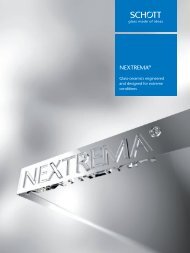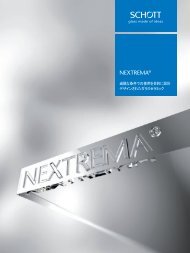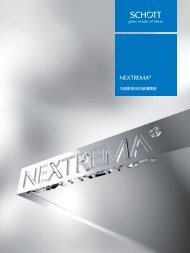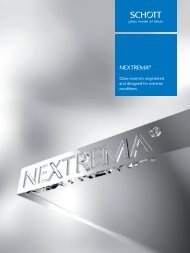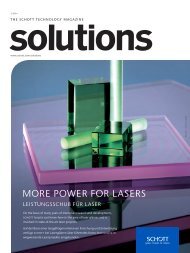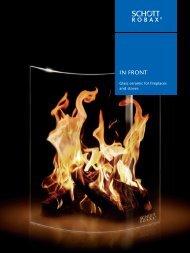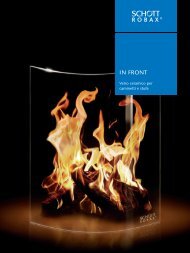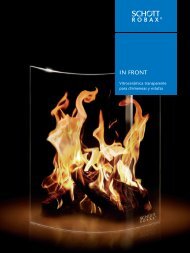SCHOTT Technical Glasses
Apart from its application in optics, glass as a technical material has exerted a formative influence on the development of important technological fields such as chemistry, pharmaceutics, automotive, optics, optoelectronics and information technology. SCHOTT Technical Glasses offers pertinent information in concise form. It contains general information for the determination and evaluation of important glass properties and also informs about specific chemical and physical characteristics and possible applications of the commercial technical glasses produced by SCHOTT. With this brochure, we hope to assist scientists, engineers, and designers in making the appropriate choice and make optimum use of SCHOTT products.
Apart from its application in optics, glass as a technical material has exerted a formative influence on the development of important technological fields such as chemistry, pharmaceutics, automotive, optics, optoelectronics and information technology. SCHOTT Technical Glasses offers pertinent information in concise form. It contains general information for the determination and evaluation of important glass properties and also informs about specific chemical and physical characteristics and possible applications of the commercial technical glasses produced by SCHOTT. With this brochure, we hope to assist scientists, engineers, and designers in making the appropriate choice and make optimum use of SCHOTT products.
Create successful ePaper yourself
Turn your PDF publications into a flip-book with our unique Google optimized e-Paper software.
I<br />
45<br />
Metal<br />
(α 20/300 in 10 –6 /K)<br />
Tungsten<br />
(4.4)<br />
Molybdenum<br />
(5.2)<br />
Molybdenum and<br />
28 Ni/18 Co/Fe<br />
(5.1)<br />
28 Ni/23 Co/Fe<br />
(7.7)<br />
51 Ni/1Cr/Fe<br />
(10.2)<br />
Cu-sheathed<br />
(α 20/400 radial 99)<br />
(α 20/400 axial 72)<br />
52–53 Ni/Fe<br />
(10.2.–10.5.)<br />
Glass no.<br />
Glass<br />
characteristics<br />
Main<br />
applications<br />
8337B borosilicate glass, highly UV-transmitting photomultiplier, UV-detectors<br />
8487 high boron content, low melting temperature<br />
flash lamps, lamp bulbs,<br />
exhaust and flare tubes, discharge lamps<br />
8689<br />
borosilicate glass, high UV-blocked,<br />
stabilized against solarization<br />
backlights<br />
8252 alkaline earth aluminosilicate glass, free from alkali halogen lamps<br />
8253<br />
alkaline earth aluminosilicate glass,<br />
free from alkali, high temperature resistance<br />
halogen lamps<br />
8242 Borosilicate glass, electricity highly insulating clad tube for optical fibers<br />
8245<br />
high boron content, low melting temperature,<br />
low x-ray absorption<br />
x-ray tubes, photomultiplier<br />
8250<br />
high boron content, low melting temperature,<br />
high electric insulation, low dieelectric losses<br />
8270 high boron content, stabilized against Tyndall backlight beads<br />
8436<br />
alkali alkaline earth silicate, sealable with sapphire,<br />
resistant to Na vapor and alkalis<br />
8350 soda-lime silicate glass, AR-GLAS ®<br />
8531<br />
8532<br />
8360<br />
8516<br />
dense-lead silicate, Na- and<br />
Li-free, low melting temp.,<br />
high electrical insulation<br />
containing FeO for hot forming by IR,<br />
low volatilization, lead-free<br />
transmitting tubes, image converters<br />
clad tubes for optical fibers,<br />
x-ray tubes, glass-to-metal seal packages<br />
low-temperature<br />
encapsulation of diodes<br />
reed switches<br />
Table 9. Special properties and principal applications of technically important sealing glasses, arranged according to their respective sealing partners<br />
3.0<br />
2.0<br />
Sealing alloy<br />
For Ni-Fe-(Cr) alloys, which are frequently used in technical<br />
applications, but also for copper-sheathed wire, glass<br />
groups belonging to the soft glass category are recommended.<br />
Such glasses usually meet certain special requirements,<br />
such as high electrical insulation (alkali-lead silicate<br />
8095), exceptionally low working temperature (dense-lead<br />
glasses 8531, 8532), etc.<br />
9<br />
[10 –3 ] ––><br />
Δ I<br />
1.0<br />
0<br />
Glass<br />
20 100 200 300 400 500 600<br />
FeO-containing glass (8516) is frequently used for hermetic<br />
encapsulation of electrical switches and electronic components<br />
in inert gas. Hot forming and sealing are easily<br />
achieved by absorption of IR radiation having its maximum<br />
intensity at 1.1 µm wavelength (Figure 39). The presence<br />
of a portion of Fe 2 O 3 makes these glasses appear green. At<br />
appropriately high IR intensities, they require considerably<br />
shorter processing times than flame-heated clear glasses.<br />
Temperature in °C ––><br />
Fig. 38. Relative thermal expansion of the components of a matched<br />
glass-to-metal seal (glass 8250 – NiCo 2918)






